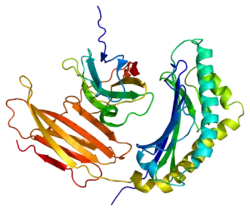Prolactin-induziertes Protein
Das Prolactin-induzierte Protein (PIP, SABP, GCDFP-15) ist ein Protein, das normalerweise im Speichel und anderen Körpersekreten von Säugetieren vorkommt, aber auch bei krankhaften Veränderungen der Milchdrüsen nachweisbar ist. Die Bindung von PIP an Aquaporin-5 in Speichel- und Tränendrüsen führt zum Transport von Aquaporin-5 in die apikale Membran; eine Veränderung dieses Prozesses scheint mitverantwortlich für das Sjögren-Syndrom zu sein. Die Fähigkeit zur Bindung an das Fc-Fragment von Immunglobulin G deutet auf mögliche immunmodulierende Funktionen für PIP. Weiterhin weist das Protein Bindungsstellen für Actin auf, außerdem bindet es an Zink-α2-Glycoprotein (ZAG); diesbezügliche Funktionen des Proteins sind nicht bekannt.[1][2][3][4][5][6]
| Prolactin-induziertes Protein | ||
|---|---|---|
 | ||
|
Vorhandene Strukturdaten: 3ES6 | ||
| Eigenschaften des menschlichen Proteins | ||
| Masse/Länge Primärstruktur | 16,6 Kilodalton / 146 Aminosäuren | |
| Sekundär- bis Quartärstruktur | Monomer | |
| Bezeichner | ||
| Gen-Namen | PIP GCDFP-15; GCDFP15; GPIP4 | |
| Externe IDs | ||
| Vorkommen | ||
| Homologie-Familie | PIP | |
| Übergeordnetes Taxon | Höhere Säugetiere | |
| Orthologe | ||
| Mensch | Hausmaus | |
| Entrez | 5304 | 18716 |
| Ensembl | ENSG00000159763 | ENSMUSG00000058499 |
| UniProt | P12273 | P02816 |
| Refseq (mRNA) | NM_002652 | NM_008843 |
| Refseq (Protein) | NP_002643 | NP_032869 |
| Genlocus | Chr 7: 143.13 – 143.14 Mb | Chr 6: 41.85 – 41.85 Mb |
| PubMed-Suche | 5304 | 18716 |
Die Produktion von PIP in Sperma, Speichel-, Tränen- und Schweißdrüsen wird durch Prolactin und Androgene erhöht, und durch Estrogen gebremst.[1]
In der pathologischen und neuropathologischen Diagnostik werden gegen GCDFP-15 gerichtete Antikörper als immunhistochemische diagnostische Marker eingesetzt.[7]
Einzelnachweise
- UniProt P12273
- Hassan MI, Bilgrami S, Kumar V, et al: Crystal structure of the novel complex formed between zinc alpha2-glycoprotein (ZAG) and prolactin-inducible protein (PIP) from human seminal plasma. In: J. Mol. Biol.. 384, Nr. 3, Dezember 2008, S. 663–72. doi:10.1016/j.jmb.2008.09.072. PMID 18930737.
- Ohashi Y, Tsuzaka K, Takeuchi T, Sasaki Y, Tsubota K: Altered distribution of aquaporin 5 and its C-terminal binding protein in the lacrimal glands of a mouse model for Sjögren's syndrome. In: Curr. Eye Res.. 33, Nr. 8, August 2008, S. 621–9. doi:10.1080/02713680802262819. PMID 18696337.
- Chiu WW, Chamley LW: Human seminal plasma prolactin-inducible protein is an immunoglobulin G-binding protein. In: J. Reprod. Immunol.. 60, Nr. 2, Dezember 2003, S. 97–111. PMID 14638438.
- Mazoujian et al.: The ultrastructural localization of gross cystic disease fluid protein (GCDFP-15) in breast epithelium. In: Am J Pathol, 1984;116(2):305-10. PMID 6205595
- Viacava et al.: Spectrum of GCDFP-15 expression in human fetal and adult normal tissues. In: Virchows Arch, 1998;432(3):255-60. PMID 9532005
- Mazoujian et al.: Immunohistochemistry of a gross cystic disease fluid protein (GCDFP-15) of the breast. A marker of apocrine epithelium and breast carcinomas with apocrine features. Am J Pathol. 1983;110(2):105-12. PMID 6130702